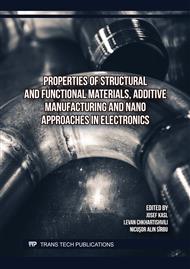[1]
P. Moriarty, Nanostructured materials, Rep. Prog. Phys. 64 (3) (2001) 297-381.
Google Scholar
[2]
F. Grillot, J. Duan, B. Dong, H. Huang, Uncovering recent progress in nanostructured light-emitters for information and communication technologies, Light Sci. Appl. 10 (2021) 156 (1-17).
DOI: 10.1038/s41377-021-00598-3
Google Scholar
[3]
R. Katsumi, Y. Ota, M. Benyoucef, Telecom-band quantum dots compatible with silicon photonics for photonic quantum applications, Adv. Quant. Technol. 8 (2025) 2300423 (1-13).
DOI: 10.1002/qute.202300423
Google Scholar
[4]
Y. Arakawa, M.J. Holmes, Progress in quantum-dot single photon sources for quantum information technologies: A broad spectrum overview, Appl. Phys. Rev. 7 (2020) 021309 (1-16).
DOI: 10.1063/5.0010193
Google Scholar
[5]
M. Gurioli, Zh. Wang, A. Rastelli, T. Kuroda, S. Sanguinetti, Droplet epitaxy of semiconductor nanostructures for quantum photonic devices, Nat. Mater. 18 (2019) 799-810.
DOI: 10.1038/s41563-019-0355-y
Google Scholar
[6]
L.-Q. Yue, Y.-L. Shi, N.-F. Sun, Sh. Qiang, J.-K. Qin, L. Zhen, Ch.-Y. Xu, InP low-dimensional nanomaterials for electronic and optoelectronic device applications: A review, Adv. Sensor Res. 2 (2023) 2200101 (1-15).
DOI: 10.1002/adsr.202200101
Google Scholar
[7]
O.I. Micic, C.J. Curtis, K.M. Jones, J.R. Sprague, A.J. Nozik, Synthesis and characterization of InP quantum dots, J. Phys. Chem. C 98 (19) (1994) 4966-4969.
DOI: 10.1021/j100070a004
Google Scholar
[8]
P. Mushonga, M.O. Onani, A.M. Madiehe, M. Meyer, Indium phosphide-based semiconductor nanocrystals and their applications, J. Nanomater. 2012 (2012) 869284 (1-11).
DOI: 10.1155/2012/869284
Google Scholar
[9]
M. Benyoucef, M. Yacob, J.P. Reithmaier, J. Kettler, P. Michler, Telecom-wavelength (1.5 μm) single-photon emission from InP-based quantum dots, Appl. Phys. Lett. 103 (16) (2013) 162101 (1-4).
DOI: 10.1063/1.4825106
Google Scholar
[10]
D. Lapherashvili, Semiconductor optical amplifier in communication, Proc. Georgian Natl. Acad. Sci. (Ser. Chem.) 42 (3) (2016) 390-394.
Google Scholar
[11]
S. Tamang, Ch. Lincheneau, Y. Hermans, S. Jeong, P. Reiss, Chemistry of InP nanocrystal syntheses, Chem. Mater. 28 (8) (2016) 2491-2506.
DOI: 10.1021/acs.chemmater.5b05044
Google Scholar
[12]
F. Zafar, A. Iqbal, Indium phosphide nanowires and their applications in optoelectronic devices, Proc. Royal Soc. A 472 (2016) 20150804 (1-18).
DOI: 10.1098/rspa.2015.0804
Google Scholar
[13]
H. Zhang, N. Hu, Z. Zeng, Q. Lin, Zh. Fengjuan, A. Tang, Y. Jia, L.S. Li, H. Shen, F. Teng, Z. Du, High-efficiency green InP quantum dot‐based electroluminescent device comprising thick-shell quantum dots, Adv. Opt. Mater. 7 (7) (2019) 1801602 (1-9).
DOI: 10.1002/adom.201801602
Google Scholar
[14]
J.-H. Jo, D.-Y. Jo, S.-H. Lee, S.-Y. Yoon, H.-B. Lim, B.-J. Lee, Y.R. Do, H. Yang, InP-based quantum dots having an InP core, composition-gradient ZnSeS inner shell, and ZnS outer shell with sharp, bright emissivity, and blue absorptivity for display devices, ACS Appl. Nano Mater. 3 (2) (2020) 1972-1980.
DOI: 10.1021/acsanm.0c00008
Google Scholar
[15]
F. Pelayo Garcia de Arquer, D.V. Talapin, V.I. Klimov, Y. Arakawa, M. Bayer, E.H. Sargent, Semiconductor quantum dots: Technological progress and future challenges, Science 373 (6555) (2021) eaaz8541 (1-14).
DOI: 10.1126/science.aaz8541
Google Scholar
[16]
D.A. Vajner, L. Rickert, T. Gao, K. Kaymazlar, T. Heindel, Quantum communication using semiconductor quantum dots, Adv. Quant. Technol. 5 (2022) 2100116 (1-40).
DOI: 10.1002/qute.202100116
Google Scholar
[17]
E.M. Sala, M. Godsland, Y.I. Na, A. Trapalis, J. Heffernan, Droplet epitaxy of InAs/InP quantum dots via MOVPE by using an InGaAs interlayer, Nanotechnology 33 (2022) 065601 (1-8).
DOI: 10.1088/1361-6528/ac3617
Google Scholar
[18]
S. Saurabh, M. Khalid Hossain, S. Singh, S. Kumar Agnihotria, D.P. Samajdar, Optical performance analysis of InP nanostructures for photovoltaic applications, RSC Adv. 13 (2023) 9878-9891.
DOI: 10.1039/d3ra00039g
Google Scholar
[19]
N. Koguchi, S. Takahashi, T. Chikyow, New MBE growth method for InSb quantum well boxes, J. Cryst. Growth 111 (1991) 688-692.
DOI: 10.1016/0022-0248(91)91064-h
Google Scholar
[20]
N. Koguchi, Self-assembly of semiconductor quantum dots by droplet epitaxy, MRS Symp. Proc. 959 (2006) 1801 (1-10).
DOI: 10.1557/proc-0959-m18-01
Google Scholar
[21]
S. Sanguinetti, S. Bietti, N. Koguchi, Droplet epitaxy of nanostructures, in: M. Henini (Ed.), Molecular Beam Epitaxy, second ed., Elsevier, Amsterdam, 2018, Ch. 13, pp.293-314.
DOI: 10.1016/b978-0-12-812136-8.00013-x
Google Scholar
[22]
A. Nemcsics, Quantum dots prepared by droplet epitaxial method, nanotechnology and nanomaterials, in: V.N. Stavrou (ed.), Quantum Dots – Theory and Applications, IntechOpen, 2015, Ch. 5, pp.119-149.
DOI: 10.5772/60823
Google Scholar
[23]
R.S.R. Gajjela, P.M. Koenraad, Atomic-scale characterization of droplet epitaxy quantum dots, Nanomaterials 11 (2021) 85 (1-24).
DOI: 10.3390/nano11010085
Google Scholar
[24]
S.F. Covre da Silva, G. Undeutsch, B. Lehner, S. Manna, T.M. Krieger, M. Reindl, C. Schimpf, R. Trotta, A. Rastelli, GaAs quantum dots grown by droplet etching epitaxy as quantum light sources, Appl. Phys. Lett. 119 (2021) 120502 (1-9).
DOI: 10.1063/5.0057070
Google Scholar
[25]
E.M. Sala, Y.I. Na, J. Heffernan, Local droplet etching with indium droplets on InP(100) by metal–organic vapor phase epitaxy, Cryst. Growth Design 24 (22) (2024) 9571-9580.
DOI: 10.1021/acs.cgd.4c01097
Google Scholar
[26]
E. Steimetz, F. Schienle, J.-T. Zettler, W. Richter, Stranski–Krastanov formation of InAs quantum dots monitored during growth by reflectance anisotropy spectroscopy and spectroscopic ellipsometry, J. Cryst. Growth 170 (1–4) (1997) 208-214.
DOI: 10.1016/s0022-0248(96)00630-6
Google Scholar
[27]
J.E. Prieto, I. Markov, Stranski–Krastanov mechanism of growth and the effect of misfit sign on quantum dots nucleation, Surf. Sci. 664 (2017) 172-184.
DOI: 10.1016/j.susc.2017.05.018
Google Scholar
[28]
Yu. Berdnikov, P. Holewa, Sh. Kadkhodazadeh, J.M. Smigiel, A. Sakanas, A. Frackowiak, K. Yvind, M. Syperek, E. Semenova, Near-critical Stranski–Krastanov growth of InAs/InP quantum dots, Sci. Rep. 14 (2024) 23697 (1-9).
DOI: 10.1038/s41598-024-70451-1
Google Scholar
[29]
T. Laperashvili, Method of Fabrication of Schottky Barrier, Patent of Georgia # 46 (1992).
Google Scholar
[30]
O. Kvitsiani, D. Laperashvil, T. Laperashvili, V. Mikelashvili, Solar cells based on InP/GaP/Si structure, Proc. SPIE 10019 (2016) 100191G (1-7).
DOI: 10.1117/12.2248086
Google Scholar
[31]
F. Hatami, Indium Phosphide Quantum Dots in GaP and in In0.48Ga0.52P. Growth and Properties (Dissertation), Humboldt–Universitatz, Berlin, 2002.
Google Scholar


